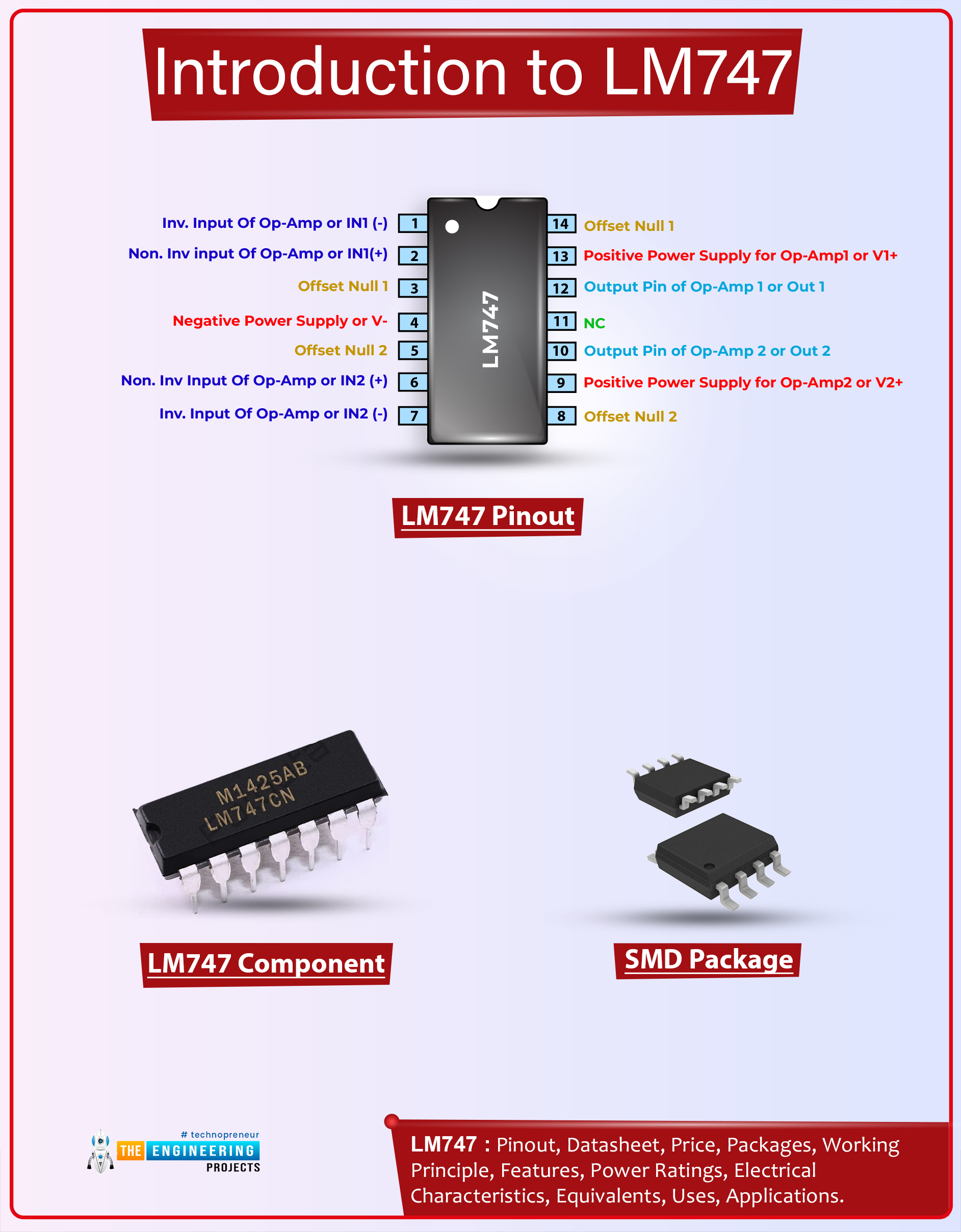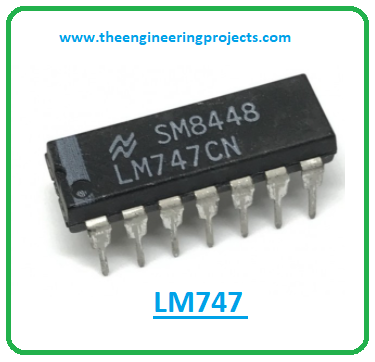
Hi Guys! I hope you’re well today. Happy to see you around. In this post today, I’ll walk you through the Introduction to LM747.
LM747 is a general-purpose dual-operational amplifier IC. This chip contains two operational amplifiers on board and belongs to the LM’xx’ family where LM stands for linear monolithic. In this chip, analog components are incorporated into silicon.
I suggest you buckle up as I’ll detail the complete Introduction to LM747 covering datasheet, pinout, features, equivalents, and applications. Let’s jump right in.
Introduction to LM747
- Designed by National Semiconductor, LM747 is a general-purpose dual-operational amplifier integrated chip.
- Two operational amplifiers are incorporated that share common power supply leads and a bias network.

- And these amplifiers are capable of performing two different operations at the same time which makes them a suitable pick for several applications. Though these amplifiers share a common bias network, they are completely independent of each other

- As two general-purpose amplifiers are used in this chip, it is used to construct op-amp circuits like differential amplification, comparator, and mathematical operations.
- This device features offset pins which are mainly used to make the output more accurate and efficient.
- It comes with no latch-up when the input common-mode range is exceeded which sets it free from oscillations.

LM747 Datasheet
Before you incorporate this device into your electrical project, it’s better to scan through the datasheet of the component that features the main characteristics of the component. You can download the datasheet of LM747 from the link given below.LM747 Pinout
LM747 incorporates 14 pins on board. The following figure shows the pinout diagram of LM747.
| Pin Description of JRC4558 | ||||
|---|---|---|---|---|
| Pin No. | Pin Description | Pin Name | ||
| 1 | Inverting input of op-amp 1 | 1IN- | ||
| 2 | A non-inverting input of op-amp 1 | 1IN+ | ||
| 3 | The offset null pin is used to remove the offset voltage and control the input voltages for op-amp 1 | OFFSET NULL 1 | ||
| 4 | Common negative supply voltage for both Op-amps | V- | ||
| 5 | The offset null pin is used to remove the offset voltage and control the input voltages for op-amp 1 | OFFSET NULL 2 | ||
| 6 | The non-inverting input of op-amp 2 | 2IN+ | ||
| 7 | Inverting input of op-amp 2 | 2IN- | ||
| 8 | The offset null pin is used to remove the offset voltage and control the input voltages for the op-amp 2 | OFFSET NULL 2 | ||
| 9 | Positive supply voltage for op-amp 2 | V2+ | ||
| 10 | The output pin of the op-amp 2 | 2OUT | ||
| 11 | No connection | NC | ||
| 12 | The output pin of the op-amp 1 | 1OUT | ||
| 13 | Positive supply voltage for op-amp1 | V1+ | ||
| 14 | The offset null pin is used to remove the offset voltage and control the input voltages for op-amp 1 | OFFSET NULL 1 | ||
- Offset null pins remove the offset voltage and balance the output voltages for both operational amplifiers.
- While pin 11 is not connected. It is not used for any purpose.
LM747 Features
The following are the main features of LM747.- No latch-up
- Large differential voltage and common mode range
- Low noise interference among op-amps
- Total power dissipation = 800mW
- Differential input voltage = ±30V
- Low power consumption
- Supply voltage Max. = ±22V
- Frequency Compensation is not required
- Comes with short-circuit protection
- Common-Mode Rejection Ratio CMRR = 90dB
- Operating temperature range = -55ºC to +125ºC
LM747 Applications
The following are the main applications of LM747.- Employed in mathematical operations
- Used in amplifiers
- Used in analog circuits
- Used for Measuring instruments
- Incorporated in voltage comparators
- Employed for Industrial applications
- Used in Peak detectors
That was all about the Introduction to LM747. If you’re unsure or have any questions, you can leave your query in the section below. I’d love to help you according to the best of my expertise. Feel free to share your valuable feedback and suggestions around the content we share so we keep sharing quality content tailored to your exact needs and requirements. Thank you for reading the article.



